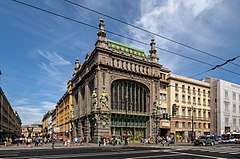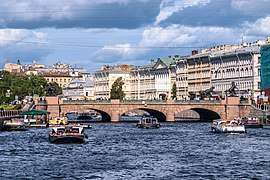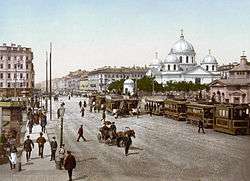Nevsky Prospect
Nevsky Prospect (Russian: Не́вский проспе́кт, tr. Nevsky Prospekt, IPA: [ˈnʲɛfskʲɪj prɐˈspʲɛkt]) is the main street (high street) in the federal city of St. Petersburg in Russia. It takes its name from the Alexander Nevsky Lavra, the monastery which stands at the eastern end of the street, and which in turn commemorates the Russian hero Prince Saint Alexander Nevsky (1221-1263). Following his founding of Saint Petersburg in 1703, Tsar Peter I planned the course of the street as the beginning of the road to Novgorod and Moscow. The avenue runs from the Admiralty in the west to the Moscow Railway Station and, after veering slightly southwards at Vosstaniya Square, to the Alexander Nevsky Lavra.
     .jpg) Clockwise from top: Kazan Cathedral, Eliseyev Emporium, Grand Hotel Europe, Stroganov Palace, Anichkov Bridge, Singer House | |
| Former name(s) | 25 October Prospect |
|---|---|
| Location | St. Petersburg |
| Coordinates | 59.9318°N 30.3528°E |


Major sights include the Rastrelliesque Stroganov Palace, the huge neoclassical Kazan Cathedral, the Art Nouveau Bookhouse (originally the Singer House), Elisseeff Emporium, half a dozen 18th-century churches, a monument to Catherine the Great, an enormous 18th-century shopping mall, a mid-19th-century department store, the Russian National Library, and the Anichkov Bridge with its horse statues.
Nikolai Gogol described the feverish life of the avenue in his story "Nevsky Prospekt", published in 1835. Fyodor Dostoevsky often employed Nevsky Prospekt as a setting in his works, such as Crime and Punishment (1866) and The Double: A Petersburg Poem (1846). The café-restaurant which the famous writers of the 19th-century Golden Age of the Russian literature frequented still remains as "Literary Cafe" on Nevsky Prospect.
During the early Soviet years (1918–44) the name of Nevsky Prospect was changed, first and briefly to "Proletkult Street" (Ulitsa Proletkul'ta) in honor of that Soviet artistic organization.[1] Following the demise of Proletkult already around 1920 the name was changed again, this time to "Avenue of the 25th of October", alluding to the day of the October Revolution: the name never took on in the daily language of the city's inhabitants who continued to use the pre-revolutionary name. During the siege of Leningrad (1941–1944) some walls on the north side of Nevsky Prospect were stencilled with the inscription "Citizens! During shelling this side of the street is the most dangerous", warning passers-by of the areas most at risk from German artillery bombardment.[2] In 1962, the inscription was recreated on school building No. 210 on Nevsky Prospect through the initiative of poet Mikhail Dudin.[2][3] The inscription, and other examples across the city, are considered war memorials and are frequently the site of commemorations of the siege. In January 2019 Governor of Saint Petersburg Alexander Beglov laid flowers at the inscription on Nevsky Prospect.[4]
At the end of the siege of Leningrad, in January 1944, the name Nevsky Prospect was formally restored and has remained ever since.[5]
The Nevsky today functions as the main thoroughfare in Saint Petersburg. The majority of the city's shopping and nightlife takes place on or immediately off Nevsky Prospekt.
The street is served by the stations Admiralteyskaya, Nevsky Prospekt, Gostiny Dvor, Mayakovskaya, Ploshchad Vosstaniya and Ploshchad Alexandra Nevskogo I of Saint Petersburg Metro.[6]
See also
- List of upscale shopping districts
Footnotes
- Lynn Mally, Culture of the Future: The Proletkult Movement in Revolutionary Russia. Berkeley, CA: University of California Press, 1990; pg. 44.
- Bratskiy, Yan (19 November 2018). "В Петербурге вандалы закрасили историческую надпись «При артобстреле эта сторона улицы наиболее опасна»" (in Russian). Zvezda. Retrieved 1 May 2019.
- Soboleva, Inna Arkadevna (2011). Утраченный Петербург (in Russian). Издательский дом "Питер". p. 132. ISBN 9785459003901.
- "Александр Беглов возложил цветы к памятной надписи на Невском проспекте" (in Russian). 5-Родной. 26 January 2019. Retrieved 1 May 2019.
- http://www.hellopiter.ru/The_neva_prospectus.html
- Nevsky Prospekt - "The Prospekt has five Metro stations along its length, with each having its own unique identity. These are; "Ploshchad Aleksandra Nevskogo", "Ploshchad Vosstaniya", "Mayakovskaya", "Gostinyy Dvor" and "Nevsky Prospekt". A sixth station called 'Admiralty' has just been built on the M5 line just off Nevsky on Bolshaya Morskaya ul."
External links
